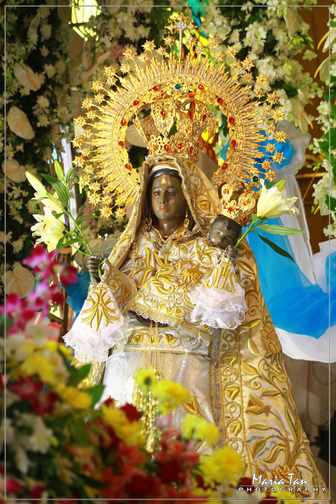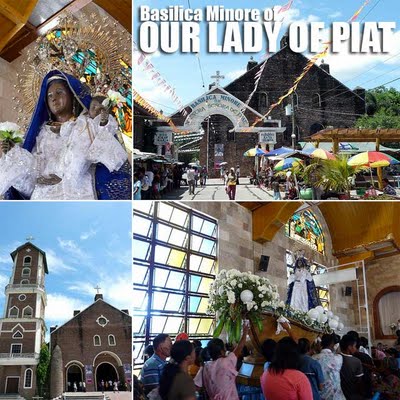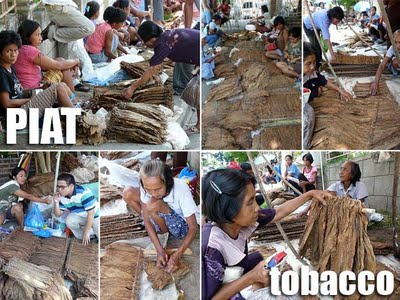The miraculous image of our Lady of the Rosary, popularly known today as our Lady of Piat, for brevity, was sculptured in Macao, then a colony of Portugal. Presumably, upon the request of the Dominican Missionaries, the image was brought to the Philippines sometime in the year 1604, and placed in Lallo, then the Episcopal See of Nueva Segovia, for the veneration of the people. When the Dominican Missionaries started the Christianization of the Itawes region, they found the natives of a very rebellious character, and they thought it valuable for their work to introduce the devotion to our Lady among the people. Eventually the image was taken to Piat, and erected on a side altar. It was not long when the people felt special manifestations of divine favors through Our Lady.
Their love and devotion to Our Lady had grown with the years, and attachement to her image bordered fantacism.

This was clearly seen when Fr. Juan de Santa Ana sent the same image to Tuguegarao in 1622 and ordered another one more beautiful from Manila to replace the image. In no time, the people rose up in public protest and asked to the point of insistence that the original image be returned to them.
Knowing the peculiar character of the people, Fr. Juan de Santa Ana finally gave in, and the image was brought back amid great rejoicing of the people. There arose, however, a dispute between the people of Piat and Tuao as to where the sanctuary should be constructed. Happily, solomonic solution was found, and it was agreed to have the sanctuary built between Piat and Tuao. The people worked with great enthusiasm on the sanctuary and in 1623, the edifice was ready. On Dec. 26, 1923, the image of Our Lady was brought in a solemn procession from the parish church of Sto.
In 1596, the Dominican Provincial, Fr. Miguel de San Jacinto named Piat as a mission in the Itawes region comprising the towns of Tabang, Malaueg, Tuao and Piat. The encomenderos then were Pedro Barreda, Juan de Arranda and Isabel de Cardona. In 1604, the Bishop, Diego de Soria, negotiated for more missionaries for the Itawes region. To help in the pacification and evangelization of the region, the Dominicans introduced the devotion to Our Lady of the Most Holy Rosary: in 1604, they brought the images of Our Lady from Macau and first enshrined it in Lallo, later bringing it to Piat 1622.
The first Holy Mass said in Piat was on August 24, 1604; on May 1, 1610, Piat was made a parish with Fr. Dominic de Guzman as titular. Fr. Melchor Manzano was named Vicar of the Itawes with Frs. Francisco Jurado and Juan Bautista Cano as assistants. In 1612, Fr. Juan de la Leiva was name Vicar of Piat and Tabang with Frs. Garcia, Diego Collado and Pedro Gascon of the Itawes with Fr. Melchor Manzano as Vicar assisted by Fr. Tomas Villar, Juan Bautista Cano, Gaspar de Casablanca. The Provincial Vicar sent three more priests to help in the Vicariate.

From Lallo, the image of Our Lady of the Most Holy Rosary was brough to Piat in 1622 and enshrined in one of the two altars of the Church of Sto. Domingo. In 1623, Fr. Juan de Sta. Ana sent the image to Tuguegarao and sent back a replica but the people protested so the image was returned in 1624 and housed in a sanctuary separate from the Sto. Domingo Church due to a quarrel between the people of Piat and Tuao. Fr. Diego started the construction of the church, which burned down in 1740; Fr. Jose Gurumeta reconstructed the church and Fr. Isidore Rodriguez put the galvanized iron roofing. The present Shrine has been constructed to meet the needs of Our Lady's devotees. The old Sanctuary, begun by Fr. Diego Pinero and restored by Father Jose Gurumeta has become too small to accomodate the many pilgrims who visit our Lady's Shrine.
Originally know as Nuestra Senora del Santissimo Rosario, Our Lady is now venerated as Our Lady of the Visitation and her feast is celebrated on July 2.
In the Itawes area, the Dominicans founded the towns of Lubo, in 1604; Malaweg, 1608; Piat, 1610; Tuao, 1612 and Tabang, 1613,. In 1725. Fr. Juan de Sto. Tomas founded Mawanan, which was accepted as a Parish in the Provincial Chapter of 1735 and raised to that status by Bishop Jose Campomanes, the last Dominican Bishop of Nueva Segovia.

Because of oppression and abuses particularly connected with tax collections, the Itawes staged several uprisings in 1603 and 1617 and also in 1718; Fr. Miguel de la Viall became the "pacificador" of the later uprising. Many people also complained about the unjust exactions of the encomenderos and many missionaries took their sides.

Outside the church is one big flea market where you can find rows of stalls and vendors selling religious images, tobacco and native kakanin among other items you can find in the usual provincial tiangge. You don't see tobacco sold in Manila that way. They're usually in reams, flip top packs or sold by the stick. Don't worry, I still don't smoke. I just wanted to try the tobacco for the fun of it.

The Piat Basilica is actually a great place to sample the local delicacies. Of all the kakanin they sold in the area, the best is the pawa, a kakanin made from ground sticky rice with sweetened ground peanut filling inside. While most vendors sell it for PHP20, I was not quite satisfied with them since they were not freshly-cooked. Later did I find out that the pawa sold in the Piat Basilica are of varying quality. There are some which make it really good and I recommend V. C. Pasinca's Pawa. A pack of this yummy treat costs PHP25. Make sure you also buy it warm to ensure the same heavenly experience I had munching on them.
Source:
http://www.ivanhenares.com/2009/08/basilica-of-our-lady-of-piat-in-piat.html
http://ourladyofpiat.blogspot.com/


